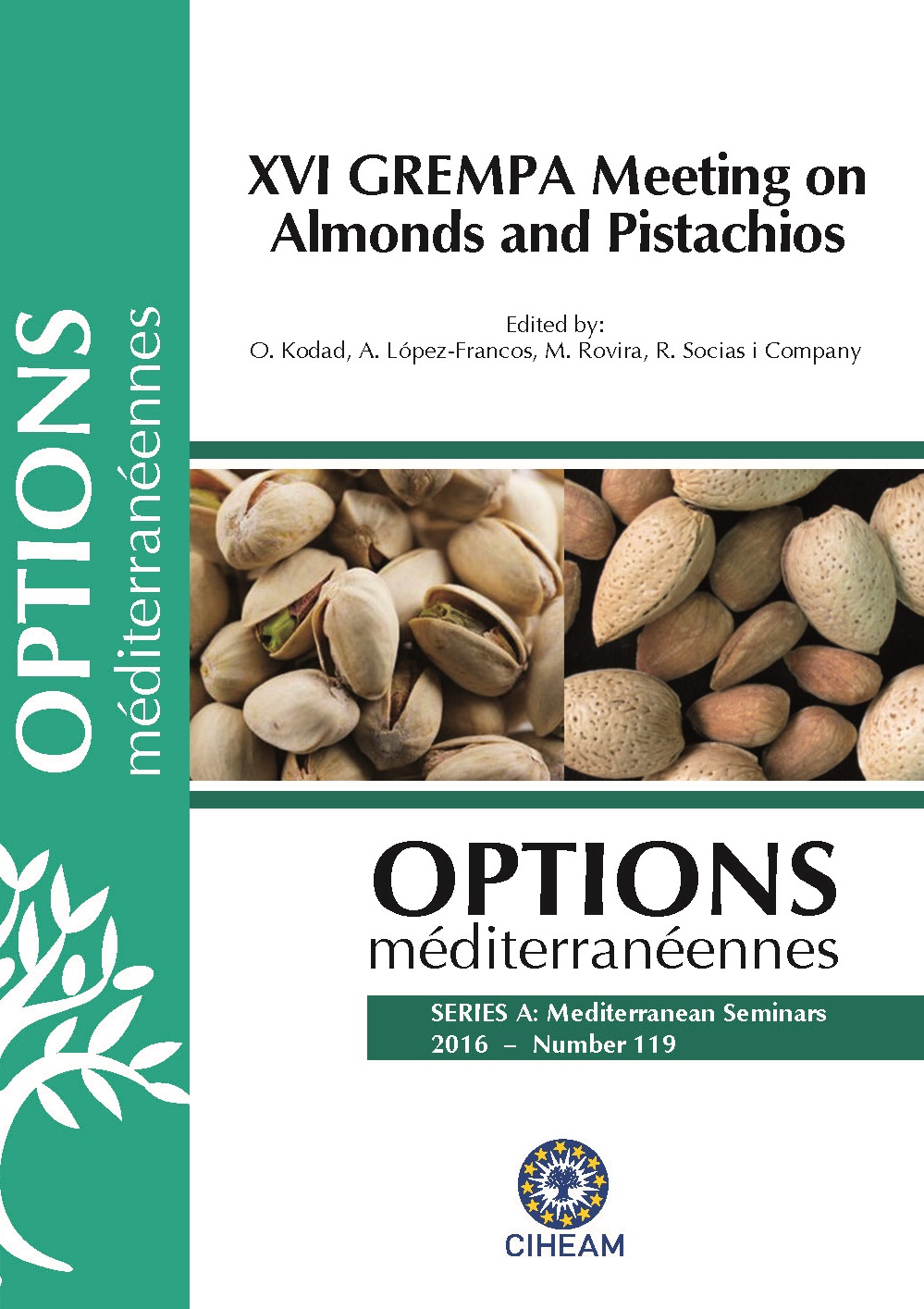| Article précédent | p. 173-176 | Article suivant |
Budding success and growth aptitude under rainfed conditions during the first year of plantation: Comparison between Pistacia terebinthus L. and UCB-I
In Spain, pistachio area was negligible in the 1990’s, nowadays, it is estimated to 6,000 hectares. However, one of the most important issues that created doubt among farmers for its introduction has been the choice of rootstock. The most used rootstocks in the world are Pistacia atlantica, Pistacia integerrima, Pistacia terebinthus and UCB-I. Pistacia terebinthus is a native Spanish forests rootstock known for its adaptation to the lands of the Iberian Peninsula. However, it is also known for its small vigor and its low tolerance to some diseases like Verticilium dahliae. In contrast, UCB-I, a hybrid between Pistacia integerrima and Pistacia atlantica is a rootstock known for its high vigor, its tolerance to Verticillium dahliae and its high yields, however, its behavior is unknown under rain-fed conditions. For this purpose, as a first step, a Split-plot trial comparing these two rootstocks with different cultivars under rain-fed conditions was implemented in Castilla-La-Mancha (Spain). The primary objective was to assess the aptitude of budding success and the difference in the vegetative growth of these two rootstocks under rain-fed conditions. Rootstock diameter, scion diameter, the percentage of budding success and the length of resulted scions were measured. The results showed that UCBI had a higher percentage of budding success (70% vs. 54%), a significantly higher rootstock and scion diameters (25 mm vs 15 mm for rootstock and 22 mm vs 15 mm for scion). However there was no difference between lengths of sprouted buds. Also, there was no influence of the variety in relation to these parameters.
En Espagne, la surface plantée en pistachiers était négligeable dans les années 1990, mais elle est estimée aujourd’hui à 6 000 hectares. Cependant, l’une des plus importantes problématiques qui rendait les agriculteurs réticents à l’introduire était le choix du porte-greffe. Les porte-greffes les plus utilisés à l’échelle mondiale sont Pistacia atlantica, Pistacia integerrima, Pistacia terebinthus et UCB-I. Pistacia terebinthus est un porte-greffe originaire des forêts espagnoles connu pour son adaptation aux terres de la Péninsule Ibérique. Toutefois, il est aussi connu pour son peu de vigueur et sa faible tolérance à certaines maladies comme Verticilium dahliae. Par contre, UCB-I, un hybride entre Pistacia integerrima et Pistacia atlantica, est un porte-greffe connu pour sa forte vigueur, sa tolérance à Verticillium dahliae et ses bons rendements, mais son comportement est inconnu en conditions pluviales. Dans ce but, comme premier pas, un essai split-plot comparant ces deux porte-greffes portant différents cultivars en conditions pluviales a été mis en place en Castilla-La-Mancha (Espagne). L’objectif premier était d’évaluer l’aptitude à un bon bourgeonnement et la différence de croissance végétative de ces deux porte-greffes en conditions pluviales. Le diamètre des porte-greffes, le diamètre des scions, le pourcentage de réussite du bourgeonnement et la longueur des scions résultants ont été mesurés. Les résultats ont montré que UCB-I a un plus grand pourcentage de réussite du bourgeonnement (70% vs 54%), des diamètres significativement plus grands pour le porte-greffe et le scion (25 mm vs 15 mm pour le porte-greffe et 22 mm vs 15 mm pour le scion). Cependant il n’y avait pas de différence entre les longueurs des bourgeons qui avaient poussé. Il n’y avait pas non plus d’influence de la variété pour ces paramètres.
- [ Afficher ]
- [ Télécharger ]
- [ Exporter la citation ]
Vous pouvez télécharger la citation au format :
- [ Imprimer ]
-
Mots-clés
ADAPTATION, PISTACIACiter cet article
Memmi H., Couceiro J.F., Gijón M.C., Pérez-López D. Budding success and growth aptitude under rainfed conditions during the first year of plantation: Comparison between Pistacia terebinthus L. and UCB-I. In : Kodad O. (ed.), López-Francos A. (ed.), Rovira M. (ed.), Socias i Company R. (ed.). XVI GREMPA Meeting on Almonds and Pistachios. Zaragoza : CIHEAM, 2016. p. 173-176. (Options Méditerranéennes : Série A. Séminaires Méditerranéens; n. 119). 16. Meeting of GREMPA (Groupe de Recherches Méditerranéennes pour l\'Amandier et Pistachier / Mediterranean Research Group for Almond and Pistachio), 2015/05/12-14, Meknes (Morocco) . http://om.ciheam.org/om/pdf/a119/00007386.pdf



